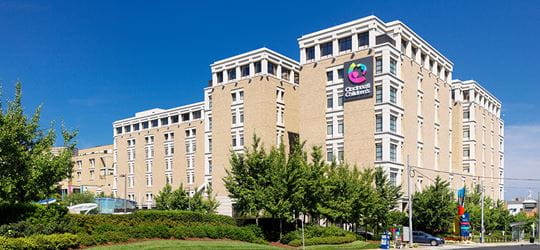
Nathan K. Evanson, MD, PhD
- Attending Physician, Division of Rehabilitation Medicine
- Assistant Professor, UC Department of Pediatrics
- nathan.evanson@cchmc.org
- Board Certified
About
Biography
I have always been a scientist at heart, and I entered medicine as a way to be a scientist. My interactions with patients and families during medical training awakened a love of clinical medicine that I continue with today.
I enjoy rehabilitation medicine because it is a broad specialty with many unexplored frontiers. I love working with children because they have so much life ahead of them, and I believe improvements early on will lead to long-term improvements in their lives.
As a rehabilitation doctor, I treat a spectrum of brain injuries, from complex concussions through severe debilitating brain injuries. These conditions include acquired brain injuries such as traumatic brain injury, stroke, inflammatory injuries and others.
Brain injury treatment requires a team approach, which includes patients, parents, physicians, therapists and many others. I believe in listening to families for their perspectives and in having them participate in making care decisions. I want to help families understand treatment options, then help them decide what approaches will work with their family situation.
In addition to helping patients and their families, I am also involved in research. The core problem I am trying to understand is how brain injuries impair brain metabolism, energy handling and cellular stress, and what can be done to correct these impairments.
MD: University of Cincinnati, Cincinnati, OH, 2010.
PhD: University of Cincinnati, Cincinnati, OH, 2008.
Residency: Pediatrics/PM&R, University of Cincinnati/Cincinnati Children's Hospital Medical Center, Cincinnati, OH.
Interests
Traumatic brain injury/acquired brain injury
Services and Specialties
Interests
Traumatic brain injury
Research Areas
Additional Languages
KoreanLocation
Insurance Information
Cincinnati Children's strives to accept a wide variety of health plans. Please contact your health insurance carrier to verify coverage for your specific benefit plan.
Publications
Use of donepezil for neurocognitive recovery after brain injury in adult and pediatric populations: a scoping review. Neural Regeneration Research. 2024; 19:1686-1695.
Reviewer Acknowledgment. The Journal of Head Trauma Rehabilitation. 2025; 40:393.
Extracranial Effects of Traumatic Brain Injury: A Narrative Review. Clinics and Practice. 2025; 15:47.
Model matters: Differential outcomes in traumatic optic neuropathy pathophysiology between blunt and blast-wave mediated head injuries. Experimental Neurology. 2024; 372:114613.
Attitudes and practices of specialty physicians regarding the return to school process after pediatric acquired brain injury. Journal of Pediatric Rehabilitation Medicine. 2023; 16:497-505.
Early Measures of TBI Severity Poorly Predict Later Individual Impairment in a Rat Fluid Percussion Model. Brain Sciences. 2023; 13:1230.
Brief Oxygen Exposure after Traumatic Brain Injury Hastens Recovery and Promotes Adaptive Chronic Endoplasmic Reticulum Stress Responses. International Journal of Molecular Sciences. 2023; 24:9831.
Chronic Histological Outcomes of Indirect Traumatic Optic Neuropathy in Adolescent Mice: Persistent Degeneration and Temporally Regulated Glial Responses. Cells. 2021; 10:3343.
Serum Biomarkers of Regeneration and Plasticity are Associated with Functional Outcome in Pediatric Neurocritical Illness: An Exploratory Study. Neurocritical Care. 2021; 35:457-467.
Pediatric Traumatic Brain Injury: Special Considerations. Brain Injury Medicine. : Springer Publishing Company; Springer Publishing Company; 2021.





Patient Ratings and Comments
All patient satisfaction ratings and comments are submitted by actual patients and verified by a leading independent experience management company, Qualtrics. Patient identities are withheld to ensure confidentiality and privacy. Only those providers whose satisfaction surveys are administered through Cincinnati Children’s Hospital Medical Center are displayed. Click here to learn more about our survey